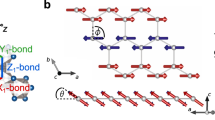Abstract
ONE approach to the problem of producing highly conducting organic materials is to synthesize molecules with unpaired electrons which are capable of interacting to produce a half-filled band and thus exhibiting near-metallic behaviour1. The free radicals examined so far do not show this behaviour2–5, mainly because their stability results from steric hindrance and electron de-localization which prevent both interaction and dimerization. In this connexion it is of interest to compare the radicals containing the N–O group, because in these the stability probably results largely from the nature of the N–O bonding.
This is a preview of subscription content, access via your institution
Access options
Subscribe to this journal
Receive 51 print issues and online access
$199.00 per year
only $3.90 per issue
Buy this article
- Purchase on Springer Link
- Instant access to full article PDF
Prices may be subject to local taxes which are calculated during checkout
Similar content being viewed by others
References
Eley, D. D., and Parfitt, G. D., Trans. Farad. Soc., 49, 79 (1953).
Eley, D. D., and Willis, M. R., Symp. Electrical Conductivity in Organic Solids, edit. by Kallmann, H., and Silver, M., 257 (Interscience, New York 1961).
Inokuchi, H., Harada, Y., and Maruyama, Y., Bull. Chem. Soc. Japan, 35, 1559 (1962).
Brown, G. P., and Aftergut, S., Proc. Princeton Conf. on Semiconduction in Molecular Solids, 37 (1960).
Chojnacki, H., Acta Phys. Polon., 21, 359 (1962).
Poirier, R. H., Kahlen, E. J., and Berrington, F., J. Org. Chem., 17, 1437 (1952).
Meyer, K., Ber., 52, 1482 (1919).
Banfield, F. H., and Kenyon, J., J. Chem. Soc., 1612 (1926).
Wieland, H., and Roth, K., Ber., 53, 210 (1920).
Eley, D. D., Jones, K. W., Littler, J. G. F., and Willis, M. R. (to be published).
Eley, D. D., and Spivey, D. J., Trans. Farad. Soc., 57, 2280 (1961).
Inokuchi, H., Bull. Chem. Soc., Japan, 27, 22 (1954).
Lyons, L. E., J. Chem. Soc., 5001 (1957).
Holden, A. N., Yager, W. A., and Merritt, F. R., J. Chem. Phys., 19, 1319 (1951).
Many, A., Harnik, E., and Gerlich, D., J. Chem. Phys., 23, 1733 (1955).
Eley, D. D., Symp. Electrical Conduction Properties of Polymers, Jet Propulsion Laboratory, California Institute of Technology (to be published in J. Polymer Sci., Part C, Polymer Symposia).
Author information
Authors and Affiliations
Rights and permissions
About this article
Cite this article
ELEY, D., JONES, K. & WILLIS, M. Semiconductivity of Free Radicals of Nitric Oxide. Nature 212, 72–73 (1966). https://doi.org/10.1038/212072b0
Issue Date:
DOI: https://doi.org/10.1038/212072b0
This article is cited by
-
Structure of organic paramagnetic nitroxyl radicals
Journal of Structural Chemistry (1975)
Comments
By submitting a comment you agree to abide by our Terms and Community Guidelines. If you find something abusive or that does not comply with our terms or guidelines please flag it as inappropriate.



